So I’ve gone on and on about all this boring stuff about writing papers and my personal experience and analysis and what not. But you probably want to know about Banguela oberlii, the pterosaur.
Let’s talk about what the paper says:
1. (We think) there’s a bona fide dsungaripterid outside of Eurasia, and it’s in Brazil. Dsungaripteridae has been reported from South America before, but these have either been questionable or ambiguous. For example, Puntanipterus globosus and Santanadactylus spixi, but the former is (probably) a synonym of Pterodaustro guinazui, whereas the other is a partial wrist that also bears resemblance to tapejarids, well known from Brazil. Puntanipterus was associated with Dsunagripterus weii on the basis of its very “swollen” ankles, but is also fairly old (earliest Cretaceous), yet it’s been discovered that Pterodaustro guinazui has very similar ankles but is clearly not a dsungaripterid, and further fossils suggested that Puntanipterus globosus is associated with clear ctenoschasmatoids. On the other hand, Santanadactylus spixi bears a distinct apomorphy of dsungaripterids in the form of fossae and ridges on the carpal bones, but at the time Tapejaridae was poorly known and similar features are present in them, as well. The wrist of spixi may thus merely be a tapejarid. It’s not quite clear.
2. Less ambiguous is the presence of an upwardly curved jaw with toothless tips and a distinctive shape and length of the mandibular symphyseal shelves. All other pterosaur jaws with upward curving tips have teeth on them … except Dsungaripterus weii.
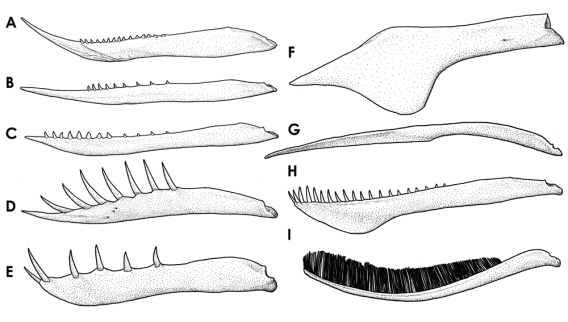
Jaws of some pterosaurs in side view. A, Dsungaripterus weii; B, Noripterus complicidens (or Noripterus parvus); C, Germanodactylus cristatus, a purported early dsungaripterid; D, Rhamphorhynchus muensteri; E, Scaphognathus crassirostris, with a slight upward curve; F, Tapejara wellnhoferi, with a distinct downward bend; G, Quetzalcoatlus sp., with a gradual downard curve along the length; H, Anhanguera piscator, with a slight upward curve; and I, Pterodaustro guinazui, with a long gradual curve.
3. Banguela oberlii is the only know dsungaripterid which has lost all its teeth (apparently). This is also convergent with several other pterosaurs. This says something of the derived jaws of dsunagripterids, which ordinarily bear specialized teeth. But dsungaripterids suggest a trend towards longer, edentate portions of the jaw tips, with fewer and fewer teeth over time. Banguela oberlii may merely be the latest in this trend, which implies there’s something intermediate. We’ll get back to this at a later time. Dsungaripterids are typically defined on the basis of the shape of their dental alveoli and, when preserved, longitudinal ridges on the palatal processes of the maxillae. These elements are missing in Banguela oberlii, but the shape of the jaw suggests other diagnostic features, including the short dorsal mandibular symphyseal shelf, and their rounded, U-shaped-ness.
4. But then again, Banguela oberlii might not be a dsungaripterid, in which case the edentate jaws are derived in shape and not toothlessness. No matter: the jaw shape is so different from other pterosaurs that it suggests a unique function, either feeding mechanics or even display. The margins of the jaw edge, forming tomia, are inset from the sides, making sloped shelves that imply the upper edge of the jaw slid past the edge of the lower jaw.
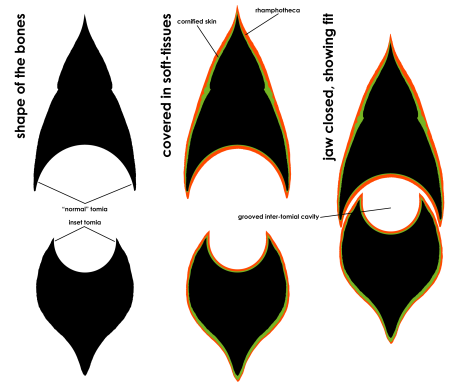
Jaws in cross-section for a hypothetical reconstruction of Banguela oberlii. Inset mandibular tomia suggest overlapping maxillary tomia, thus when meeting as jaws close the upper jaw overlaps the lower in side view.
But the tip of the jaw is slender, thin, forming a middle ridge. This is one of the features that Veldmeijer et al. compared well with Thalassodromeus sethi and suggested to Kellner a skimmer-like function for the jaw. But without a skimmer-like behavior, what might such a feature be used for? I’ll get back to you on that.
5. Regardless of its affinities, Banguela oberlii is highly diagnostic. We used an apomorphic suite (a series of characters which, on their own not “distinct,” may be used to define a species) and in the process also determined several diagnostic autapomorphies. From the paper:
Monofenestratan pterosaur bearing a distinct suite of character states (an asterisk ‘*’ indicates an autapomorphy, numbers referring to characters in Figure 3): tip of jaw inclined dorsally (1), the height of which is 2.5 times or greater than its width (2); tip of jaw piriform in cross-section,widest ventral tomid-height*(3), lacking vmk(4); tip of jaw bears dmk (5), dividing caudally into marginal tomia (6) that are inset lingually (7) for the entire length of the mandibular symphysis*(8); sides of mandibular rami diverge caudally, broadening along the symphysis (9), with concave dorsal profile; ventral margin of the jaw has a mediolaterally compressed‘chin’ (10) offset rostrally from the ventral mandibular fossa* (11), which lacks distinct emargination (12); dorsal mandibular shelf deeply embayed, ventral to 75% mandibular height*(13) and as short as ventral mandibular shelf (14); ventral mandibular shelf U-shaped in aspect (15).
These numbers refer to our comparative figure 3:
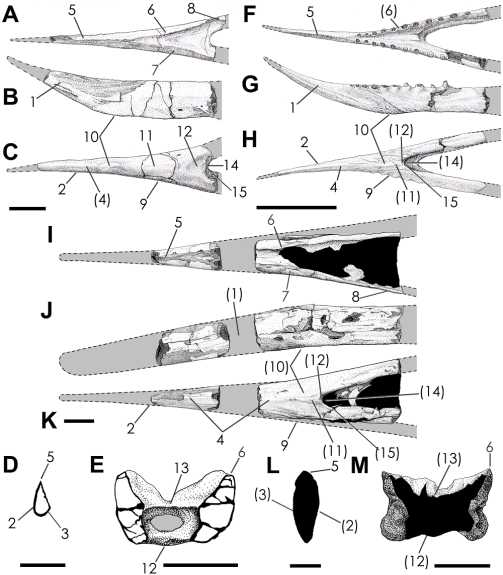 We were particularly interested in the features of the jaw that were similar amongst the three species shown, those taxa most similar to NMSG SAO 251093 (an alphanumeric series which I can now write in my sleep) across all Pterosauria. In all specimens, the tips of the jaws are toothless and bear what we call a “dorsal midline keel” all the way to the tip, or as far as we can tell. In Thalassodromeus sethi, the tip of the lower jaw is preserved, but its shape is different from that of every other toothless pterosaur known. We hint at this in the paper, but will get to this eventually; my dotted line suggests its shape from the fragments of jaw known. Reconstructions of Thalassodromeus sethi showing the tip of the jaw short and upwardly-curved were based on NMSG SAO 251093, including that in Kellner and Campos’s original description.
We were particularly interested in the features of the jaw that were similar amongst the three species shown, those taxa most similar to NMSG SAO 251093 (an alphanumeric series which I can now write in my sleep) across all Pterosauria. In all specimens, the tips of the jaws are toothless and bear what we call a “dorsal midline keel” all the way to the tip, or as far as we can tell. In Thalassodromeus sethi, the tip of the lower jaw is preserved, but its shape is different from that of every other toothless pterosaur known. We hint at this in the paper, but will get to this eventually; my dotted line suggests its shape from the fragments of jaw known. Reconstructions of Thalassodromeus sethi showing the tip of the jaw short and upwardly-curved were based on NMSG SAO 251093, including that in Kellner and Campos’s original description.
6. The shape of pterosaur mandibular symphyses is far more complicated than has been given credit. Hopefully, future work will clarify how the jaws of pterosaurs developed over time. Banguela oberlii is mainly diagnosed on features of the symphysis, including the presence of a small rounded “chin” on the bottom of the jaw and its separation from the rear margin, whereas this “chin” is often flush with the margin in other pterosaurs or (as in anhanguerids) at the very tip.
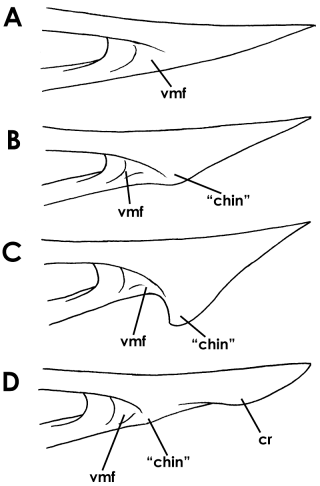
The relationship between mandibular ventral processes, the “chin,” and the fossa at the back that marks the location for the gular or hyoid musculature. Typically, the fossa is isolated (A). But it is also accompanied in some pterosaurs by a ventral midline expansion, which can be termed a “chin” or crest, as in Pteranodon (B). In tapejarids, this crest is very, very deep (C) and the fossa can extend onto is rear surface. In anhanguerids (D), however, there is both a rear ventral expansion (“chin”) and a distinct crest (“cr”) at the tip of the jaw. In Banguela oberlii, the fossa and “chin” do not contact, nor is the crest towards the tip of the jaw, a unique feature of the species.
7. The pterosaur mandible (much like the pelvis) is woefully under-represented in pterosaur phylogenies. In fact, descriptions of the mandible, of the symphysis or even of the medial side of the mandibular rami, are most often brief if present at all (yes, there are some exceptions). We used the description of Banguela oberlii to look further into the details of pterosaur jaws, and hope this spurs more detailed examination in the future.
8. There’s much to say about Thalassodromeus sethi, but some important tidbits that you can derive from the paper itself: The mandible was bent somewhat downward, its upper and lower margins nearly parallel to one another, and are narrowed into a very slender blade. It is no wonder Alex Kellner considered the jaw very similar to that of the black skimmer, Rhynchops nigra. But there the similarities end. It’s a fair bet that, even though Stu Humphries et al. used the jaw of Banguela oberlii to argue Thalassodromeus sethi couldn’t skim, they’d still derive numbers from the actual jaw that would show that flying with one’s mandible through the water as a skimmer does would be problematic for an animal its size. So the paper doesn’t deal with this topic at all.
9. So what about that dorsal midline keel? Well, what about it? Only four groups of pterosaurs have it: Rhamphorhynchus muensteri has it, but its very short and restricted to the toothless tip. Dsungaripterus weii has it, and similarly is restricted to the toothless tip; but other dsungaripterid jaws don’t seem to have it, as it is absent in Noripterus complicidens. Banguela oberlii has it, and this may suggest a synapomorphy of an internal clade, or a convergence with Dsungaripterus weii. And of course Thalassodromeus sethi has it, but Tapejaridae and jaws referred to Tupuxuara species do not. The keel was probably covered in the keratinous rhamphothecal sheath, as one might expect in “beaked” animals.
I reconstructed Rhamphorhynchus muensteri‘s skull with one of these beaks, as visible if you cycle through the header image a few times, but the structure in Rhamphorhynchus might not be a keratinous beak. For all the UV investigation, this structure has received no attention. Peter Wellnhofer proposed at one point that Rhamphorhynchus was a skimmer, generlaly base don the similarity of little Rhamphorhynchus longicaudus‘ round-tipped and straight toothless “prow” to that of Rhynchops nigra. While skimming might work for the smaller pterosaurs, whose body mass is low enough to permit its food intake to exceed its energy expenditure, such a function is easily dismissed for Banguela oberlii — and quite likely Dsungaripterus weii.
10. Ah, but what about 10?
As a final tidbit, one that’s not in the paper, here’s a speculative skull reconstruction of Banguela oberlii.
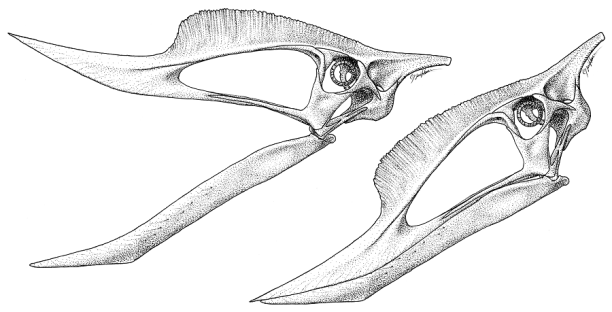
Hypothetical reconstruction of the skull of Banguela oberlii, rendered as a stipple drawing. Skull is inferred from comparison to dsungaripterids, and the front of the upper jaw from inferrence with how a jaw would interact with the lower in a “typical” animal — generally birds. Only the front half of the lower jaw is known.
For a pterosaur like this, the preserved jaw is almost half that of the full jaw … if it were dsungaripterid. This reconstruction supposes that, but as I wrote it has good reason to. There must be some reason for the loss of teeth and the development of just peculiar jaws in a pterosaur, and for all pterosaurs the shift from toothedness to toothlessness is a particularly messy one. But it only happens after the advent of the Dsungaripteridae–Azhdarchidae–Anhangueridae clade. Not only were these pterosaurs larger than their precursors, including the ctenochasmatoids who dominated the pterosaur biomass crossing the Jurassic-Cretaceous boundary, they seem far more adapted to long-range flight. Was the loss of teeth a mechanic advantage feeding on some types of foods more easily foraged abroad that ahome? or was the loss of teeth a need to conserve energy in development, favoring toothless forms that could wander further? But that is also something I had little room to touch on in the paper, and will eventually get back to.
Headden, J. A. & Campos, H. B. N. 2014. An unusual edentulous pterosaur from the Early Cretaceous Romualdo Formation of Brazil. Historical Biology [Published online ahead of print]: 1-13. doi: 10.1080/08912963.2014.904302
Humphries, S., Bonser, R. H. C., Witton, M. P. & Martill, D. M. 2009. Did pterosaurs feed by skimming? Physical modelling and anatomical evaluation of an unusual feeding method. PLoS Biology 5 (8): e204.
Kellner, A. W. A. & Campos, D. de A. 2002. The function of the cranial crest and jaws of a unique pterosaur from the early Cretaceous of Brazil. Science 297: 389-392.
Naish, D., Simpson, M. & Dyke, G. 2013. A new small-bodied azhdarchoid pterosaur from the Lower Cretaceous of England and its implications for pterosaur anatomy, diversity and phylogeny. PLoS ONE 8 (3): e58451.
Veldmeijer, A. J., Signore, M., Meijer, H. J. M. 2005. Description of two pterosaur (Pterodactyloidea) mandibles from the Lower Cretaceous Santana Formation, Brazil. Deinsea 11: 67-86.



One more fact, another blog discusses how the blogger sculpted a Banguela skull (https://imaginosaurus.wordpress.com/category/pterosaur-4-banguela-oberlii/). I think this might be very interesting for you.
Yes! I’m familiar with Helder’s work. He started on this early into the process of the work on the paper with discussion with my coauthor, Hebert Campos. Fine work.
Pingback: A Look Back at the Bite Stuff, 2014 Edition | The Bite Stuff